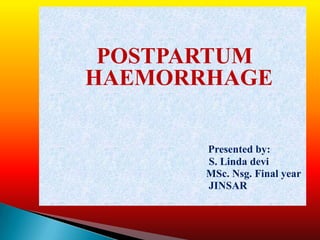
Pph
- 1. POSTPARTUM HAEMORRHAGE Presented by: S. Linda devi MSc. Nsg. Final year JINSAR
- 2. Post-partum haemorrhage (PPH) remains a major cause of maternal mortality and morbidity worldwide. Approximately, half a million women die annually from causes related to pregnancy and childbirth.
- 3. Postpartum haemo- rrhage refers to any amount of bleeding from or into the genital tract following birth of the baby upto the end of puerperium.
- 4. In the developing world, several countries have maternal mortality rates in excess of 1000 women per 100,000 live births, and World Health Organization statistics suggest that 25% of maternal deaths are due to PPH, accounting for more than 100,000 maternal deaths per year.
- 5. Primary postpartum hemorrhage is the hemorrhage occurring during the third stage of labor and within 24 hours of delivery. Secondary postopartum hemorrhage is hemorrhage occurring after 24hours of delivery and within 6weeks of delivery. It is also referred to as puerperal hemorrhage.
- 6. Primary postpartum hemorrhage are: Atonic uterus Trauma Mixed ( combination of both atonic and trauma) Retained product of conception Uterine rupture Uterine inversion Blood coagulopathy
- 7. 2.Secondary postpartum haemorrhage include: Retained bits of cotyledon or membranes. Infection Cervico-vaginal laceration Endometritis Subinvolution of the placental site Secondary hemorrhage from caesarean section Other rare causes – chorion epithelioma, carcinoma cervix, placental polyp, fibroid polyp and puerperal inversion of uterus.
- 8. Prolonged third stage of labor Multiple delivery Episiotomy Fetal macrosomia History of postpartum hemorrhage. Grandmultiparity Placenta previa Placental abruption Pregnancy induced hypertension Infection
- 9. massive blood loss passing large clots dizziness lightheadedness or fatigue. Decreased blood pressure. Increased heart rate Swelling and pain in tissues in the vaginal and perineal area
- 10. Tone – Atonic uterus 70% Trauma – laceration, hematoma, inversion, rupture 20% Tissue – Retained tissue, invasive placenta 10% Thrombin – Coagulopathies 1%
- 11. Antenatal Improvement of the health status. High risk patients. Blood grouping Intranatal Slow delivery of the baby. Expert obstetric anesthetist needed. Spontaneous separation and delivery of placenta during caesarean section.
- 12. Active management of third stage of labor. Examination of placenta. Induced or accelerated labor by oxytocin. Exploration of utero-vaginal canal. To observe the patient for about two hours after delivery.
- 13. Rub up the uterus to stimulate contraction and retraction. Administer ergometrine(0.2mg) intramuscularly . Syntometrine (1ml) intramuscularly may be given instead of ergometrine. Expel the placenta with the next uterine contraction by fundal pressure or controlled cord traction. Empty the urinary bladder by catheterization. A second dose of syntometrine or ergometrine may be given in ten minutes if bleeding is not controlled.
- 14. Tone Uterine massage - If the uterus is soft, massage is performed by placing one hand in the vagina and pushing against the body of the uterus while the other hand compresses the fundus from above through the abdominal wall. The posterior aspect of the uterus is massaged with the abdominal hand and the anterior aspect with the vaginal hand.
- 16. Uterotonic agents - Uterotonic agents include oxytocin, ergot alkaloids, and prostaglandins. Oxytocin - 10 international units (IU) should be injected intramuscularly, or 20 IU in 1 L of saline may be infused at a rate of 250 mL per hour. As much as 500 mL can be infused over 10 minutes without complications. Methylergonovine (Methergine) and ergometrine, a typical dose of methylergo-novine, 0.2 mg administered intramuscularly, may be repeated as required at intervals of two to four hours.
- 17. Prostaglandins – Carboprost can be administered intra- myometrially or intramuscularly in a dose of 0.25 mg; this dose can be repeated every 15 minutes for a total dose of 2 mg. Misoprostol is another prostaglandin; It can be administered sublingually, orally, vaginally, and rectally. Doses range from 200 to 1,000 mcg; the dose recommended by FIGO is 1,000 mcg administered rectally.
- 18. Trauma Lacerations and hematomas resulting from birth trauma can cause significant blood loss that can be lessened by hemostasis and timely repair. Uterine Rupture - Symptomatic uterine rupture requires surgical repair of the defect or hysterectomy. Uterine inversion is rare.
- 20. Classic signs of placental separation include a small gush of blood with lengthening of the umbilical cord and a slight rise of the uterus in the pelvis. Placental delivery can be achieved by use of the Brandt-Andrews maneuver, which involves applying firm traction on the umbilical cord with one hand while the other applies suprapubic counter-pressure.
- 21. Thrombin Coagulation disorders, a rare cause of post-partum hemorrhage, are unlikely to respond to the measures described above. Most coagulopathies are identified before delivery, allowing for advance planning preventing postpartum hemorrhage.
- 22. Transvaginal uterine packing Conservative surgical approach - Uterine Artery Ligation, Ovarian Artery Ligation, Vaginal Artery Ligation, Internal Iliac Ligation, Angiographic Arterial Embolization, Hysterectomy.
- 23. Blood loss Shock Death Septicemia Orthostatic hypotension Anemia Fatigue
- 24. Postpartum hemorrhage, defined as the loss of more than 500 mL of blood after delivery, occurs in up to 18 percent of births.1,2 Blood loss exceeding 1,000 mL is considered physiologically significant and can result in hemodynamic instability. Uterine atony is responsible for most cases and can be managed with uterine massage in conjunction with oxytocin, prostaglandins, and ergot alkaloids.
